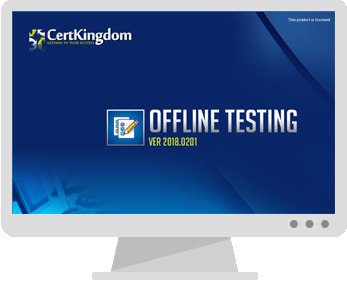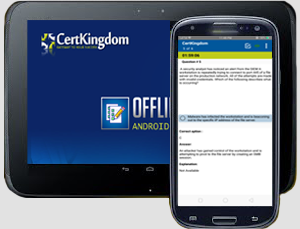Exam: 70-669

|
|||||||||||||||||||||||||||
Certkingdom's preparation material includes the most excellent features, prepared by the same dedicated experts who have come together to offer an integrated solution. We provide the most excellent and simple method to pass your certification exams on the first attempt "GUARANTEED"
Whether you want to improve your skills, expertise or career growth, with Certkingdom's training and certification resources help you achieve your goals. Our exams files feature hands-on tasks and real-world scenarios; in just a matter of days, you'll be more productive and embracing new technology standards. Our online resources and events enable you to focus on learning just what you want on your timeframe. You get access to every exams files and there continuously update our study materials; these exam updates are supplied free of charge to our valued customers. Get the best 70-669 exam Training; as you study from our exam-files "Best Materials Great Results"
70-669 Exam + Online / Offline and Android Testing Engine & 4500+ other exams included
$50 - $25 (you save $25)
Buy Now
Exam 70-669
TS: Windows Server 2008 R2, Desktop Virtualization
About this Exam
This exam focuses on desktop virtualization technologies such as Windows Virtual PC, MED-V, Windows XP Mode for Windows 7, App-V, Remote Desktop Services, Virtual Desktop Infrastructure (VDI), Windows Server 2008 R2 environments, and Microsoft Hyper-V Server 2008 R2.
Audience Profile
Candidates for this exam should have more than one and a half years of experience as virtualization administrators working with desktop virtualization technologies such as Windows Virtual PC, MED-V, Windows XP Mode for Windows 7, App-V, Remote Desktop Services, Virtual Desktop Infrastructure (VDI), Windows Server 2008 R2 environments, and Microsoft Hyper-V Server 2008 R2. Additionally, candidates have experience with server virtualization products and technologies, including Hyper-V, System Center Virtual Machine Manager 2008 R2, Windows PowerShell 2.0, and System Center Configuration Manager.
Credit Toward Certification
When you pass Exam 70-669: TS: Windows Server 2008 R2, Desktop Virtualization, you complete the requirements for the following certification(s):
Microsoft Certified Technology Specialist: Windows Server 2008 R2, Desktop Virtualization
Exam 70-669: TS: Windows Server 2008 R2, Desktop Virtualization: counts as credit toward the following certification(s):
Microsoft Certified IT Professional: Virtualization Administrator
Skills Being Measured
This exam measures your ability to accomplish the technical tasks listed below. The percentages indicate the relative weight of each major topic area on the exam.
Deploying and Managing an Enterprise Desktop Virtualization Environment
* Install and configure Windows Virtual PC.
o This objective may include but it is not limited to: installing Windows Virtual PC on various platforms (32-bit, 64-bit), creating and managing virtual hard disks, configuring virtual machine resources including network resources, preparing host machines
* Enable and manage Windows XP Mode.
o This objective may include but it is not limited to: enable Windows XP Mode for Windows 7; publish applications to a host OS through Windows XP Mode; configure the BIOS to support hardware virtualization; create, deploy, and maintain Windows XP Mode images
* Create a MED-V infrastructure.
o This objective may include but it is not limited to: installing and managing server components (Image Repository, MED-V Instances), installing the MED-V client, configuring server settings
* Administer a MED-V environment.
o This objective may include but it is not limited to: managing workspaces, creating policies, publishing applications and menus, configuring reporting, customizing user and device settings in a virtual machine
* Create and deploy virtual desktop images.
o This objective may include but it is not limited to: using various tools to create or prepare images for deployment, deploying a workspace image by using a Web page, pre-staging images
Deploying and Managing a Presentation Virtualization Environment
* Prepare and manage remote applications.
o This objective may include but it is not limited to: configuring application sharing, package applications for deployment by using RemoteApp, installing and configuring the RD Session Host Role Service on the server.
* Access published applications.
o This objective may include but it is not limited to: configuring Remote Desktop Web Access, configuring internal and external application access, configuring role-based application provisioning, configuring Remote Desktop client connections
* Configure client settings to access virtualized desktops.
o This objective may include but it is not limited to: configuring client settings, managing user home folders, identifying minimum client requirements
Deploying and Managing an Application Virtualization (App-V) Environment
* Prepare virtual applications.
o This objective may include but is not limited to: sequencing applications, installing and configuring the sequencer, preparing applications for deployment in different environments, configuring virtual application interaction and sharing, choosing a method to deploy virtual applications
* Install and configure application virtualization environments.
o This objective may include but is not limited to: configuring App-V modes (stand-alone, lightweight, enterprise); install an App-V infrastructure including servers, management consoles, and clients
* Manage application virtualization environments.
o This objective may include but is not limited to: enabling and monitoring offline application usage, enabling and monitoring real-time sessions, managing application cache, configuring branch cache functionality
Managing a Virtual Desktop Infrastructure Environment
* Configure user state virtualization.
o This objective may include but is not limited to: configuring roaming profiles, configuring folder redirection
* Manage virtual desktops remotely.
o This objective may include but is not limited to: working with Virtual Machine Manager Self-Service Portal (SSP) to log in to, control, restart, or resume a desktop virtual machine, working with Remote Desktop Manager, working with Remote Desktop Licensing Manager, troubleshooting client Key Management Server (KMS) issues, configuring firewall exceptions on the client
Make yourself more valuable in today's competitive computer industry Certkingdom's preparation material includes the most excellent features, prepared by the same dedicated experts who have come together to offer an integrated solution. We provide the most excellent and simple method to pass your Microsoft MCTS 70-669 exam on the first attempt "GUARANTEED".
Unlimited Access Package
will prepare you for your exam with guaranteed results, 70-669 Study Guide. Your exam will download as a single 70-669 PDF or complete 70-669 testing engine as well as over +4000 other technical exam PDF and exam engine downloads. Forget buying your prep materials separately at three time the price of our unlimited access plan - skip the 70-669 audio exams and select the one package that gives it all to you at your discretion: 70-669 Study Materials featuring the exam engine.
Certkingdom 70-669 Exam Prepration Tools
Certkingdom Microsoft MCTS preparation begins and ends with your accomplishing this credential goal. Although you will take each Microsoft MCTS online test one at a time - each one builds upon the previous. Remember that each Microsoft MCTS exam paper is built from a common certification foundation.
70-669 Exam Testing Engines
Beyond knowing the answer, and actually understanding the 70-669 test questions puts you one step ahead of the test. Completely understanding a concept and reasoning behind how something works, makes your task second nature. Your 70-669 quiz will melt in your hands if you know the logic behind the concepts. Any legitimate Microsoft MCTS prep materials should enforce this style of learning - but you will be hard pressed to find more than a Microsoft MCTS practice test anywhere other than Certkingdom.
70-669 Exam Questions and Answers with Explanation
This is where your Microsoft MCTS 70-669 exam prep really takes off, in the testing your knowledge and ability to quickly come up with answers in the 70-669 online tests. Using MCTS 70-669 practice exams is an excellent way to increase response time and queue certain answers to common issues.
70-669 Exam Study Guides
All Microsoft MCTS online tests begin somewhere, and that is what the Microsoft MCTS training course will do for you: create a foundation to build on. Study guides are essentially a detailed Microsoft MCTS 70-669 tutorial and are great introductions to new Microsoft MCTS training courses as you advance. The content is always relevant, and compound again to make you pass your 70-669 exams on the first attempt. You will frequently find these 70-669 PDF files downloadable and can then archive or print them for extra reading or studying on-the-go.
70-669 Exam Video Training
For some, this is the best way to get the latest Microsoft MCTS 70-669 training. However you decide to learn 70-669 exam topics is up to you and your learning style. The Certkingdom Microsoft MCTS products and tools are designed to work well with every learning style. Give us a try and sample our work. You'll be glad you did.
70-669 Other Features
* Realistic practice questions just like the ones found on certification exams.
* Each guide is composed from industry leading professionals real Microsoft MCTSnotes, certifying 100% brain dump free.
* Study guides and exam papers are guaranteed to help you pass on your first attempt or your money back.
* Designed to help you complete your certificate using only
* Delivered in PDF format for easy reading and printing Certkingdom unique CBT 70-669 will have you dancing the Microsoft MCTS jig before you know it
* MCTS 70-669 prep files are frequently updated to maintain accuracy. Your courses will always be up to date.
Get MCTS ebooks from Certkingdom which contain real 70-669 exam questions and answers. You WILL pass your MCTS exam on the first attempt using only Certkingdom's MCTS excellent preparation tools and tutorials.
These are real testimonials. Hi friends! CertKingdom.com is No1 in sites coz in $50 I cant believe this but when I purchased the $50 package it was amazing I Microsoft passed 10 Exams using CertKingdom guides in one Month So many thanks to CertKingdom Team , Please continue this offer for next year also. So many Thanks
Mike CA
Thank You! I would just like to thank CertKingdom.com for the Microsoft MCTS 70-669 test guide that I bought a couple months ago and I took my test and pass overwhelmingly. I completed the test of 174 questions in about 90 minutes I must say that their Q & A with Explanation are very amazing and easy to learn.
Jay Brunets
After my co-workers found out what I used to pass Microsoft MCTS 70-669 the test, that many are thinking about purchasing CertKingdom.com for their MCTS exams, I know I will again
John NA
I passed the Microsoft MCTS 70-669 exam yesterday, and now it's on to security exam. Couldn't have done it with out you. Thanks very much.
Oley R.
Hello Everyone
I Just Passed The Microsoft MCTS 70-669 Took 80 to 90 Minutes max to understand and easy to learn. Thanks For Everything Now On To 70-669
Robert R.
Hi CertKingdom.com thanks so much for your assistance in Microsoft MCTS i passed today it was a breeze and i couldn't have done it without you. Thanks again
Seymour G.
I have used your Exam Study Guides for preparation for Microsoft MCTS 70-669. I also passed all those on the first round. I'm currently preparing for the Microsoft and theMCTS. exams
Ken T.
I just wanted to thank you for helping me get myMCTS $50 package for all guides is awesome you made the journey a lot easier. I passed every test the first time using your Guide
Mario B.
I take this opportunity to express my appreciation to the authors of CertKingdom.com Microsoft MCTS test guide. I purchased the 70-669 soon after my formal hands on training and honestly, my success in the test came out of nowhere but CertKingdom.com. Once again I say thanks
Kris H.
Dear CertKingdom.com team the test no. 70-669 that i took was very good, I received 880 and could have gain more just by learning your exams
Gil L.
Hi and Thanks I have just passed the MCTS Directory Services Design exam with a score of 928 thanks to you! The guide was excellent
Edward T.
Great stuff so far....I love this site....!! I am also on the Microsoft MCTS I decided to start from certkingdom and start learning study MCTS from home... It has been really difficult but so far I have managed to get through 4 exams....., now currently studying for the more exams.... Have a good day.................................................. Cheers
Ted Hannam
Thanks for your Help, But I have finally downloaded Microsoft MCTS 70-669 exam preparation from certkingdom.com they are provided me complete information about the exam, lets hope I get success for the 70-669 exam, I found there exams very very realistic and useful. thanks again
lindsay Paul
Certkingdom Offline Testing Engine Simulator Download
Prepare with yourself how CertKingdom Offline Exam Simulator it is designed specifically for any exam preparation. It allows you to create, edit, and take practice tests in an environment very similar to an actual exam.
Supported Platforms: Windows-7 64bit or later - EULA | How to Install?
FAQ's: Windows-8 / Windows 10 if you face any issue kinldy uninstall and reinstall the Simulator again.
Download Offline Simulator-Beta
Certkingdom Testing Engine Features
- Certkingdom Testing Engine simulates the real exam environment.
- Interactive Testing Engine Included
- Live Web App Testing Engine
- Offline Downloadable Desktop App Testing Engine
- Testing Engine App for Android
- Testing Engine App for iPhone
- Testing Engine App for iPad
- Working with the Certkingdom Testing Engine is just like taking the real tests, except we also give you the correct answers.
- More importantly, we also give you detailed explanations to ensure you fully understand how and why the answers are correct.
Certkingdom Android Testing Engine Simulator Download
Take your learning mobile android device with all the features as desktop offline testing engine. All android devices are supported.
Supported Platforms: All Android OS EULA
Install the Android Testing Engine from google play store and download the app.ck from certkingdom website android testing engine download

Certkingdom Android Testing Engine Features
- CertKingdom Offline Android Testing Engine
- Make sure to enable Root check in Playstore
- Live Realistic practice tests
- Live Virtual test environment
- Live Practice test environment
- Mark unanswered Q&A
- Free Updates
- Save your tests results
- Re-examine the unanswered Q & A
- Make your own test scenario (settings)
- Just like the real tests: multiple choice questions
- Updated regularly, always current




